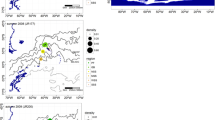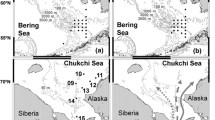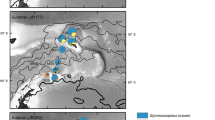Abstract
Recent research has illuminated biological processes taking place during the polar night in the high Arctic, while simultaneously, the polar regions are undergoing rapid climate-driven change. There is a pressing need for research to establish baseline conditions and understand the influence of oceanographic factors on polar communities. We collected plankton samples in Kongsfjorden (Svalbard, Arctic) in January 2020, in order to study the early life-history stages of benthic invertebrates during the polar night. Specimens were identified using morphology and DNA barcoding. During our field campaign, a strong wind event occurred, which caused upwelling of Arctic water in the fjord. Therefore, we also investigated the influence of oceanographic factors on benthic invertebrate larvae, including temperature, salinity, and depth. Our samples included 19 different species or morphotypes belonging to ten invertebrate phyla, including three embryo morphotypes. The collection of embryos indicates that at least some taxa are reproducing in the polar night. Larval community structure at shallow stations was significantly different before and after the upwelling event. Our samples also reflected patchiness in the larval community and a significant influence of depth. The most common nutrition mode among the larval taxa we collected was lecithotrophy (energy derived from maternal yolk), but we also collected a few taxa that may be planktotrophic (feeding). Development via lecithotrophy could increase larval survival and settlement success in the low-food environment of the Arctic winter. This study provides essential data on the early life-history stages of benthic invertebrates in an understudied season.







Similar content being viewed by others
Data availability
Raw data are provided in Online Resource 1.
References
Anderson M, Gorley R, Clarke K (2008) Permanova+ for Primer: guide to software and statistical methods. Primer-E, Plymouth
Benoit D, Simard Y, Gagne J et al (2010) From polar night to midnight sun: photoperiod, seal predation, and the diel vertical migrations of polar cod (Boreogadus saida) under landfast ice in the Arctic Ocean. Polar Biol 33:1505–1520. https://doi.org/10.1007/s00300-010-0840-x
Berge J, Cottier F, Varpe Ø et al (2014) Arctic complexity: a case study on diel vertical migration of zooplankton. J Plankton Res 36:1279–1297. https://doi.org/10.1093/plankt/fbu059
Berge J, Daase M, Renaud PE et al (2015a) Unexpected levels of biological activity during the polar night offer new perspectives on a warming Arctic. Curr Biol 25:2555–2561. https://doi.org/10.1016/j.cub.2015.08.024
Berge J, Johnsen G, Nilsen F et al (2005) Ocean temperature oscillations enable reappearance of blue mussels Mytilus edulis in Svalbard after a 1000 year absence. Mar Ecol Prog Ser 303:167–175. https://doi.org/10.3354/meps303167
Berge J, Renaud PE, Darnis G et al (2015b) In the dark: a review of ecosystem processes during the Arctic polar night. Prog Oceanogr 139:258–271. https://doi.org/10.1016/j.pocean.2015.08.005
Beszczyńska-Möller A, Fahrbach E, Schauer U, Hansen E (2012) Variability in Atlantic water temperature and transport at the entrance to the Arctic Ocean, 1997–2010. ICES J Mar Sci 69:852–863. https://doi.org/10.1093/icesjms/fst048
Brandner MM, Stübner E, Reed AJ et al (2017) Seasonality of bivalve larvae within a high Arctic fjord. Polar Biol 40:263–276. https://doi.org/10.1007/s00300-016-1950-x
Burdon-Jones C (1952) Development and biology of the larva of Saccoglossus horsti (Enteropneusta). Philos Trans R Soc London B 639:553–590
Clough LM, Ambrose WG, Ashjian CJ et al (1997) Meroplankton abundance in the Northeast Water Polynya: insights from oceanographic parameters and benthic abundance patterns. J Mar Sys 10:343–357
Conway DVP (2012) Marine zooplankton of southern Britain. Part 1: Radiolaria, Heliozoa, Foraminifera, Ciliophora, Cnidaria, Ctenophora, Platyhelminthes, Nemertea, Rotifera and Mollusca. In: John AWG (ed) Marine Biological Association of the United Kingdom Occassional Publications No. 25, Plymouth
Cottier F, Nilsen F, Skogseth R et al (2010) Arctic fjords: a review of the oceanographic environment and dominant physical processes. In: Howe J, Austin W, Forwick M, Paetzel M (eds) Fjord systems and archives. Geological Society, London, pp 35–50
Cottier F, Tverberg V, Inall M et al (2005) Water mass modification in an Arctic fjord through cross-shelf exchange: the seasonal hydrography of Kongsfjorden, Svalbard. J Geophys Res Ocean 110:1–18. https://doi.org/10.1029/2004JC002757
Cottier FR, Nilsen F, Inall ME et al (2007) Wintertime warming of an Arctic shelf in response to large-scale atmospheric circulation. Geophys Res Lett 34:L10607. https://doi.org/10.1029/2007GL029948
Eleftheriou A, Basford DJ (1983) The general behaviour and feeding of Cerianthus lloydi Gosse (Anthozoa, Coelenterata). Cah Biol Mar 24:147–158
Ershova EA, Descoteaux R, Wangensteen OS et al (2019) Diversity and distribution of meroplanktonic larvae in the Pacific Arctic and connectivity with adult benthic invertebrate communities. Front Mar Sci 6:490. https://doi.org/10.3389/fmars.2019.00490
Flyachinskaya LP, Lesin PA (2006) Using 3D reconstruction method in the investigations of Bivalvia larval development (by the example of Hiatella arctica L.). Proc Zool Inst Russ Acad Sci 310:45–50
Freire AS, Absher TM, Cruz-Kaled AC et al (2006) Seasonal variation of pelagic invertebrate larvae in the shallow antarctic waters of Admiralty Bay (King George Island). Polar Biol 29:294–302. https://doi.org/10.1007/s00300-005-0052-y
Grall J, Le Loc’h F, Guyonnet B, Riera P (2006) Community structure and food web based on stable isotopes (δ15N and δ13C) analysis of a North Eastern Atlantic maerl bed. J Exp Mar Biol Ecol 338:1–15
Gremillet D, Kuntz G, Gilbert C et al (2005) Cormorants dive through the Polar night. Biol Lett 1:469–471. https://doi.org/10.1098/rsbl.2005.0356
Grenvald JC, Callesen TA, Daase M et al (2016) Plankton community composition and vertical migration during polar night in Kongsfjorden. Polar Biol 39:1879–1895. https://doi.org/10.1007/s00300-016-2015-x
Hare MP, Palumbi SR, Butman CA (2000) Single-step species identification of bivalve larvae using multiplex polymerase chain reaction. Mar Biol 137:953–961
Hayward P, Ryland J (1990) The marine fauna of the British Isles and north-west Europe 1. Clarendon Press, Oxford, Introduction and protozoans to arthropods
Hegseth EN, Assmy P, Wiktor JM et al (2019) Phytoplankton seasonal dynamics in Kongsfjorden, Svalbard and the adjacent shelf. In: Hop H, Wiencke C (eds) The ecosystm of Kongsfjorden. Springer, Svalbard, pp 173–227
Hiebert TC, Von DG, Hiebert LS, Maslakova S (2013) The peculiar nemertean larva pilidium recurvatum belongs to Riserius sp., a basal heteronemertean that eats Carcinonemertes errans, a hoplonemertean parasite of Dungeness crab. Invertebr Biol 132:207–225. https://doi.org/10.1111/ivb.12023
Holyoak AR (1988) Spawning, egg mass formation, and larval development of the trochid gastropod Margarites helicinus (Fabricius). The Veliger 31:111–113
Hop H, Pearson T, Hegseth EN et al (2002) The marine ecosystem of Kongsfjorden, Svalbard. Polar Res 21:167–208. https://doi.org/10.1111/j.1751-8369.2002.tb00073.x
Kraft A, Berge J, Varpe Ø, Falk-Petersen S (2013) Feeding in Arctic darkness: mid-winter diet of the pelagic amphipods Themisto abyssorum and T. libellula. Mar Biol 160:241–248. https://doi.org/10.1007/s00227-012-2065-8
Kukliński P, Berge J, McFadden L et al (2013) Seasonality of occurrence and recruitment of Arctic marine benthic invertebrate larvae in relation to environmental variables. Polar Biol 36:549–560. https://doi.org/10.1007/s00300-012-1283-3
Maldonado M (2006) The ecology of the sponge larva. Can J Zool 84:175–194. https://doi.org/10.1139/Z05-177
Maslakova S (2010) The invention of the pilidium larva in an otherwise perfectly good spiralian phylum Nemertea. Integr Comp Biol 50:734–743. https://doi.org/10.1093/icb/icq096
Maturilli M (2020) Continuous meteorological observations at station Ny-Ålesund (2020-01). Alfred Wegener Institute, Research Unit Potsdamhttps://doi.org/10.1594/PANGAEA.914805
Meyer KS, Sweetman AK, Kuklinski P et al (2017) Recruitment of benthic invertebrates in high Arctic fjords: relation to temperature, depth, and season. Limnol Oceanogr 62:2732–2744. https://doi.org/10.1002/lno.10602
Michelsen HK, Svensen C, Reigstad M et al (2017) Seasonal dynamics of meroplankton in a high-latitude fjord. J Mar Syst 168:17–30. https://doi.org/10.1016/j.jmarsys.2016.12.001
Moen FE, Svensen E (2004) Marine fish & invertebrates of northern Europe. AquaPress, Essex
Onarheim IH, Smedsrud LH, Ingvaldsen RB, Nilsen F (2014) Loss of sea ice during winter north of Svalbard. Tellus A 66:1–9. https://doi.org/10.3402/tellusa.v66.23933
Ostaszewska K, Bałazy P, Berge J et al (2017) Seabirds during Arctic polar night: underwater observations from Svalbard archipelago, Norway. Waterbirds 40:302–308
Pechenik JA (1999) On the advantages and disadvantages of larval stages in benthic marine invertebrate life cycles. Mar Ecol Prog Ser 177:269–297
Porter JS, Ryland JS, Carvalho GR (2002) Micro- and macrogeographic genetic structure in bryozoans with different larval strategies. J Exp Mar Biol Ecol 272:119–130
Prestud P, Strøm H, Goldman H (2004) A catalogue of the terrestrial and marine species of Svalbard. Norwegian Polar Institute, Tromsø
Rice ME (1976) Larval development and metamorphosis in Sipuncula. Am Zool 16:563–571
Rivkin RB, Bosch I, Pearse JS, Lessard EJ (1986) Bacterivory: a novel feeding mode for asteroid larvae. Science 233:1311–1314
Sejr MK, Sand MK, Jensen KT et al (2002) Growth and production of Hiatella arctica (Bivalvia) in a high-Arctic fjord (Young Sound, Northeast Greenland). Mar Ecol Prog Ser 244:163–169
Shanks AL (2009) Pelagic larval duration and dispersal distance revisited. Biol Bull 216:373–385
Shilling FM, Bosch I (1994) Pre-feeding embryos of Antarctic and temperate echinoderms use dissolved organic material for growth and metabolic needs. Mar Ecol Prog Ser 109:173–182
Smith KE, Thatje S (2013) Nurse egg consumption and intracapsular development in the common whelk Buccinum undatum (Linneaus 1758). Helgol Mar Res 67:109–120
Soltwedel T, Bauerfeind E, Bergmann M et al (2015) Natural variability or anthropogenically-induced variation? Insights from 15 years of multidisciplinary observations at the arctic marine LTER site HAUSGARTEN. Ecol Indic 65:89–102. https://doi.org/10.1016/j.ecolind.2015.10.001
Stanwell-Smith D, Peck LS, Clarke A et al (1999) The distribution, abundance and seasonality of pelagic marine invertebrate larvae in the maritime Antarctic. Philos Trans R Soc B 354:471–484
Stübner EI, Søreide JE, Reigstad M et al (2016) Year-round meroplankton dynamics in high-Arctic Svalbard. J Plankton Res 38:522–536
Svendsen H, Beszczynska-Møller A, Hagen JO et al (2002) The physical environment of Kongsfjorden – Krossfjorden, an Arctic fjord system in Svalbard. Polar Res 21:133–166. https://doi.org/10.1111/j.1751-8369.2002.tb00072.x
van den Heuvel-Greve MJ, van den Brink A, Glorius ST et al (2021) Early detection of marine non-indigenous species on Svalbard by DNA metabarcoding of sediment. Polar Biol. https://doi.org/10.1007/s00300-021-02822-7
Wagner N (1885) Die Wirbellosen des Weissen Meeres. Erster Band: zoologische Forschungen an der Küste des Solowetzkischen Meerbusens in den Sommermonaten der Jahre 1877, 1878, 1879 und 1882. W. Engelmann, Leipzig
Weydmann-Zwolicka A, Bałazy P, Kukliński P et al (2021) Meroplankton seasonal dynamics in the high Arctic fjord: comparison of different sampling methods. Prog Oceanogr 190:102484. https://doi.org/10.1016/j.pocean.2020.102484
Wiencke C, Hop H (2016) Ecosystem Kongsfjorden: new views after more than a decade of research. Polar Biol 39:1679–1687. https://doi.org/10.1007/s00300-016-2032-9
Willis K, Cottier F, Kwasniewski S et al (2006) The influence of advection on zooplankton community composition in an Arctic fjord (Kongsfjorden, Svalbard). J Mar Syst 61:39–54. https://doi.org/10.1016/j.jmarsys.2005.11.013
Willis KJ, Cottier FR, Kwaśniewski S (2008) Impact of warm water advection on the winter zooplankton community in an Arctic fjord. Polar Biol 31:475–481. https://doi.org/10.1007/s00300-007-0373-0
Young CM, Sewell MA, Rice MA (2001) Atlas of marine invertebrate larvae. Academic Press, Cambridge
Zmudczyńska-Skarbek K, Bałazy P (2017) Following the flow of ornithogenic nutrients through the Arctic marine coastal food webs. J Mar Sys 168:31–37
Acknowledgements
We thank the staff of the Sverdrup research station and Kings Bay AS, especially Helge Tore Markussen, Vera Sklet, Marine Ilg, and Erlend Havenstrøm, for their excellent support in the field. This project was funded by a cooperative agreement between Woods Hole Oceanographic Institution and the Ocean University of China (WHOI project #18548200). X.S. Liu also received funding from the Fundamental Research Funds for the Central Universities (No. 201964024). We especially appreciate the detailed comments provided by Jørgen Berge, William Froneman, and two anonymous reviewers that greatly strengthened this manuscript.
Funding
This project was funded by a cooperative agreement between Woods Hole Oceanographic Institution and the Ocean University of China (WHOI project #18548200). XSL also received funding from the Fundamental Research Funds for the Central Universities (No. 201964024).
Author information
Authors and Affiliations
Contributions
All authors designed the study and collected data; KMK analyzed the data and wrote the manuscript; all authors edited the manuscript.
Corresponding author
Ethics declarations
Conflict of interest
The authors declare they have no conflicts of interest.
Human and animal rights statement
This research did not involve any human subjects. Animal (zooplankton) specimens were collected and handled according to ethical best-practices for marine biology.
Additional information
Publisher's Note
Springer Nature remains neutral with regard to jurisdictional claims in published maps and institutional affiliations.
Supplementary Information
Below is the link to the electronic supplementary material.
Rights and permissions
About this article
Cite this article
Meyer-Kaiser, K., Chen, H., Liu, X. et al. Oceanographic influence on the early life-history stages of benthic invertebrates during the polar night. Polar Biol 44, 1781–1793 (2021). https://doi.org/10.1007/s00300-021-02918-0
Received:
Revised:
Accepted:
Published:
Issue Date:
DOI: https://doi.org/10.1007/s00300-021-02918-0




